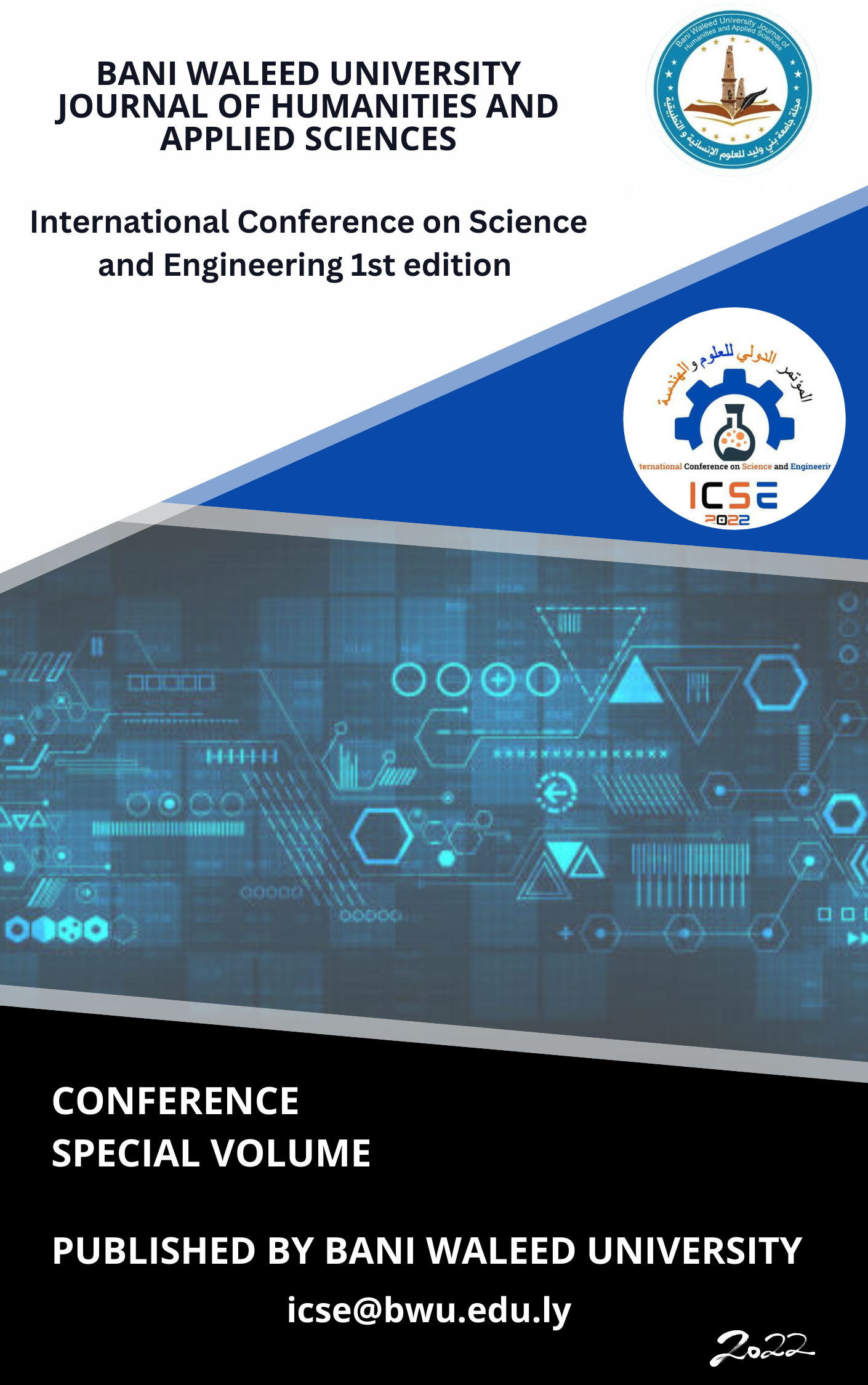Comparison between Non-linear and ANN Models for Prediction of Corrosion Inhibition Efficiency of Mild Steel
DOI:
https://doi.org/10.58916/jhas.v7i6.576الكلمات المفتاحية:
الانجليزيةالملخص
Abstract: QSAR can assist in the quick and low-cost identification of new corrosion inhibitor compounds. Early research revealed a connection between a molecule's quantum parameters and inhibition efficiency (IE). A possible nonlinear equation between experimental inhibition efficiencies (IEexp) of corrosion inhibitors and some quantum parameters was sought for some Triazole derivatives in previous study. This work aims to compare nonlinear model from previous study and artificial neural network (ANN) used in this study to predict inhibition efficiency. The investigation shows that ANN is more efficient and accurate than nonlinear model to predict inhibition efficiencies, where correlation coefficient R (between IEexp and predicted inhibition efficiency (IEpred)) increased from 0.95 to 0.99 and mean square error decreased from 4.0×10-3 to 6.1×10-5respectively.
التنزيلات
المراجع
References
Fang, J., & Li, J. (2002). Quantum chemistry study on the relationship between molecular structure and corrosion inhibition efficiency of amides. Journal of Molecular Structure: THEOCHEM, 593(1–3), 179–185. DOI: 10.1016/s0166-1280(02)00316-0
Murmu, M., Saha, S. K., Murmu, N. C., & Banerjee, P. (2019). Effect of stereochemical conformation into the corrosion inhibitive behaviour of double azomethine based Schiff bases on mild steel surface in 1 mol L− 1 HCl medium: An experimental, density functional theory and molecular dynamics simulation study. Corrosion Science, 146, 134-151.
DOI: 10.1016/j.corsci.2018.10.002
Fernandes, C. M., Alvarez, L. X., dos Santos, N. E., Barrios, A. C. M., & Ponzio, E. A. (2019). Green synthesis of 1-benzyl-4-phenyl-1H-1, 2, 3-triazole, its application as corrosion inhibitor for mild steel in acidic medium and new approach of classical electrochemical analyses. Corrosion Science, 149, 185-194. DOI: 10.1016/j.corsci.2019.01.019
Jalgham, R. T. (2021). Theoretical, Monte Carlo simulations and QSAR studies on some triazole derivatives as corrosion inhibitors for mild steel in 1 M HCl. ES Energy & Environment, 13, 37-49. DOI: 10.30919/esee8c476
A lamri, A. H., & Alhazmi, N. (2022). Development of data driven machine learning models for the prediction and design of pyrimidine corrosion inhibitors. Journal of Saudi Chemical Society, 26(6), 101536. DOI: 10.1016/j.jscs.2022.101536
Zhou, P., Yang, L., Hou, Y., Duan, G., Yu, B., Li, X., ... & Wang, F. (2021). Grain refinement promotes the formation of phosphate conversion coating on Mg alloy AZ91D with high corrosion resistance and low electrical contact resistance. Corrosion Communications, 1, 47-57. DOI: 10.1016/j.corcom.2021.05.001
Allam, N. K. (2007). Thermodynamic and quantum chemistry characterization of the adsorption of triazole derivatives during Muntz corrosion in acidic and neutral solutions. Applied Surface Science, 253(10), 4570–4577. DOI: 10.1016/j.apsusc.2006.10.008
El Ashry, El Sayed & El Nemr, Ahmed & Essawy, Samy & Ragab, Safaa. (2006). Corrosion inhibitors part 3: quantum chemical studies on the efficiencies of some aromatic hydrazides and Schiff bases as corrosion inhibitors of steel in acidic medium. ARKIVOC: archive for organic chemistry. 205-220. DOI: 10.3998/ark.5550190.0007.b21
Khadom, A. A., Mahdi, M. S., & Mahood, H. B. (2020). Mathematical regression and artificial neural network for prediction of corrosion inhibition process of steel in acidic media. Journal of Bio-and Tribo-Corrosion, 6(3), 1-10. DOI: 10.1007/s40735-020-00390-7
Samide, A., Stoean, C., & Stoean, R. (2019). Surface study of inhibitor films formed by polyvinyl alcohol and silver nanoparticles on stainless steel in hydrochloric acid solution using convolutional neural networks. Applied Surface Science, 475, 1-5. DOI: 10.1016/j.apsusc.2018.12.255
Boucherit, M. N., Amzert, S. A., Arbaoui, F., Boukhari, Y., Brahimi, A., & Younsi, A. (2019). Modelling input data interactions for the optimization of artificial neural networks used in the prediction of pitting corrosion. Anti-Corrosion Methods and Materials. DOI: 10.1108/ACMM-07-2018-1976
Al-Hazam, H. A. (2010). Prediction of corrosion inhibitor efficiency of some aromatic hydrazides and schiff bases compounds by using artificial neural network. Journal of Scientific Research, 2(1), 108-113. DOI: 10.3329/jsr.v2i1.2757
Boukhari, Y., Boucherit, M. N., Zaabat, M., Amzert, S., & Brahimi, K. (2017). Artificial intelligence to predict inhibition performance of pitting corrosion. Journal of Fundamental and Applied Sciences, 9(1), 309-322. DOI: 10.4314/jfas.v9i1.19
Musa, A. Y., Mohamad, A. B., Takriff, M. S., & Jalgham, R. T. (2012). Electrochemical and quantum chemical studies on phthalhydrazide as corrosion inhibitor for mild steel in 1 M HCl solution. Research on Chemical Intermediates, 38(2), 453-461. DOI: 10.1007/s11164-011-0362-3
Ouchenane, S., Jalgham, R., Rezgoun, S., Saifi, H., & Bououdina, M. (2021). Experimental and theoretical studies of the corrosion inhibition properties of 2 amino, 4–6-dimethylpyrimidine for Mild Steel in 0.5 M H2SO4. Chemistry Africa, 4(3), 621-633. DOI: 10.1007/s42250-021-00239-7
Musa, A. Y., Jalgham, R. T. T., & Mohamad, A. B. (2012). Molecular dynamic and quantum chemical calculations for phthalazine derivatives as corrosion inhibitors of mild steel in 1M HCl. Corrosion Science, 56, 176–183. DOI: 10.1016/j.corsci.2011.12.005
Khaled, K. F. (2010). Experimental and molecular dynamics study on the inhibition performance of some nitrogen containing compounds for iron corrosion. Materials Chemistry and Physics, 124(1), 760–767. DOI: 10.1016/j.matchemphys.2010.07.055
Khaled, K. F. (2010). Electrochemical behavior of nickel in nitric acid and its corrosion inhibition using some thiosemicarbazone derivatives. Electrochimica Acta, 55(19), 5375–5383. DOI: 10.1016/j.electacta.2010.04.079
Musa, A. Y., Mohamad, A. B., Kadhum, A. A. H., Takriff, M. S., & Ahmoda, W. (2012). Quantum chemical studies on corrosion inhibition for series of thio compounds on mild steel in hydrochloric acid. Journal of Industrial and Engineering Chemistry, 18(1), 551–555. DOI: 10.1016/j.jiec.2011.11.131
Álvarez, P. M., García-Araya, J. F., Beltrán, F. J., Masa, F. J., & Medina, F. (2005). Ozonation of activated carbons: Effect on the adsorption of selected phenolic compounds from aqueous solutions. Journal of Colloid and Interface Science, 283(2), 503–512. DOI: 10.1016/j.jcis.2004.09.014
Dagdag, O., Berisha, A., Safi, Z., Dagdag, S., Berrani, M., Jodeh, S., Verma, C., Ebenso, E. E., Wazzan, N., & El Harfi, A. (2020). Highly durable macromolecular epoxy resin as anticorrosive coating material for carbon steel in 3% NaCl: Computational supported experimental studies. Journal of Applied Polymer Science, 137(34), 49003. DOI: 10.1002/app.49003
Asadi, N., Ramezanzadeh, M., Bahlakeh, G., & Ramezanzadeh, B. (2019). Utilizing Lemon Balm extract as an effective green corrosion inhibitor for mild steel in 1M HCl solution: A detailed experimental, molecular dynamics, Monte Carlo and quantum mechanics study. Journal of the Taiwan Institute of Chemical Engineers, 95, 252–272. DOI: 10.1016/j.jtice.2018.07.011
Lukovits, I., Kálmán, E., & Pálinkás, G. (1995). Nonlinear Group-Contribution Models of Corrosion Inhibition. CORROSION, 51(3), 201–205. DOI: 10.5006/1.3294362.








